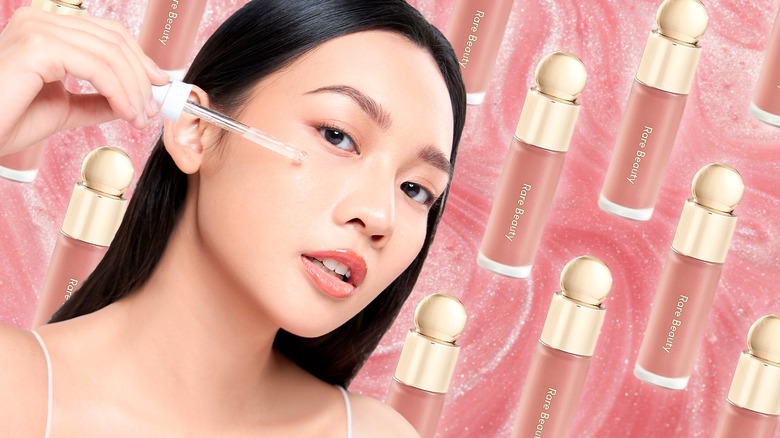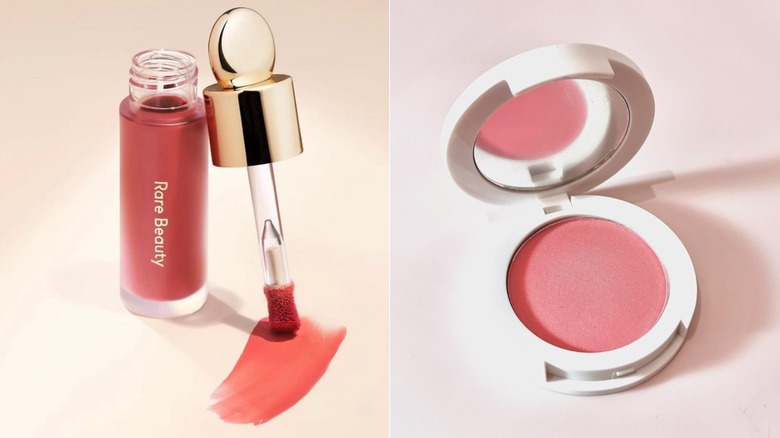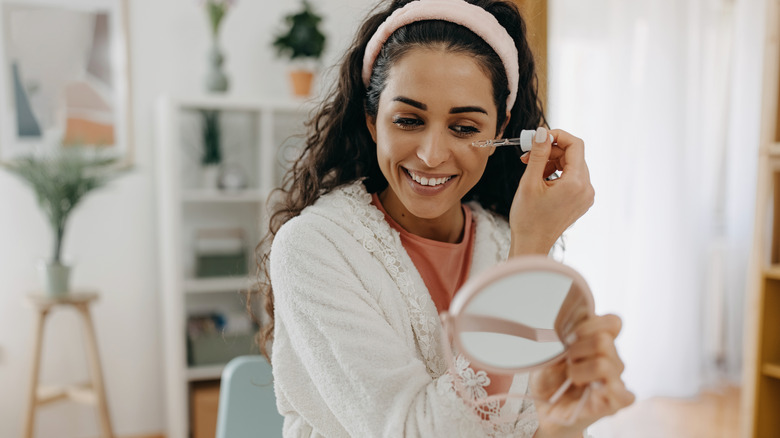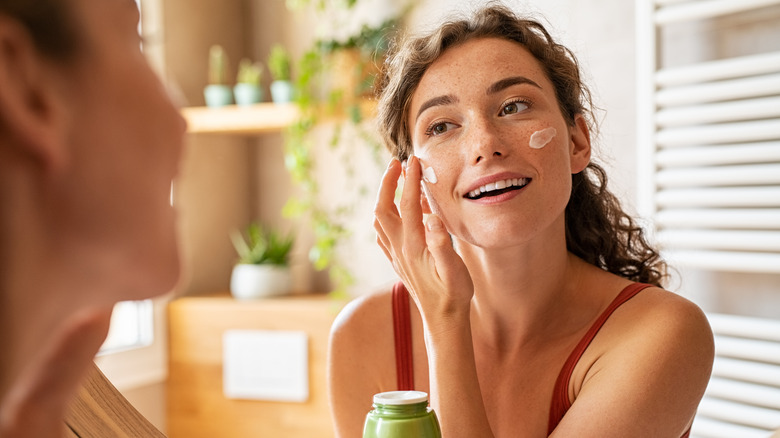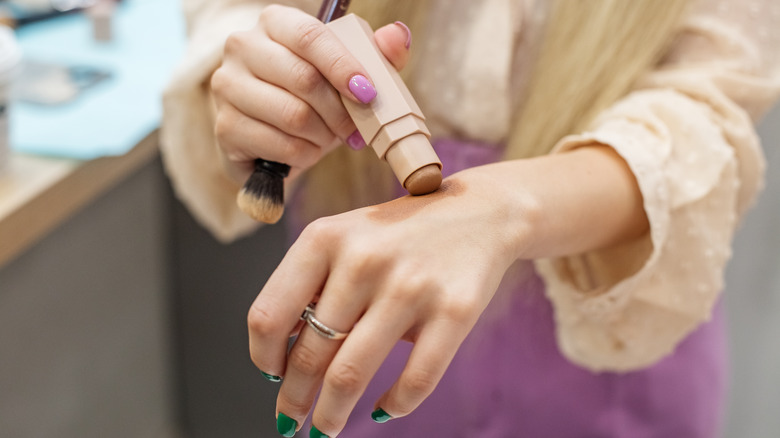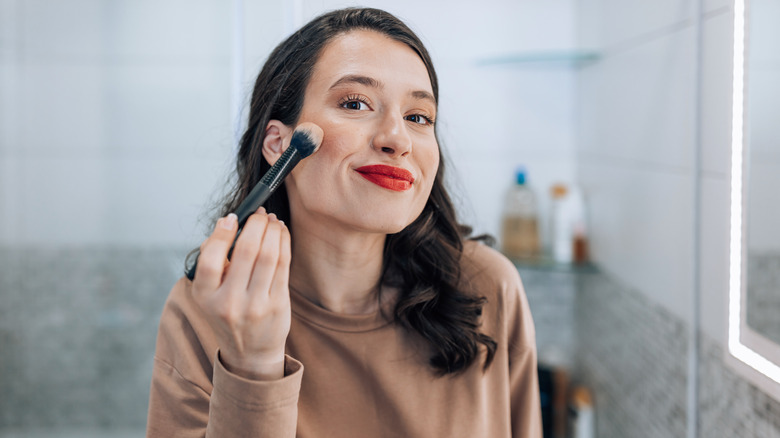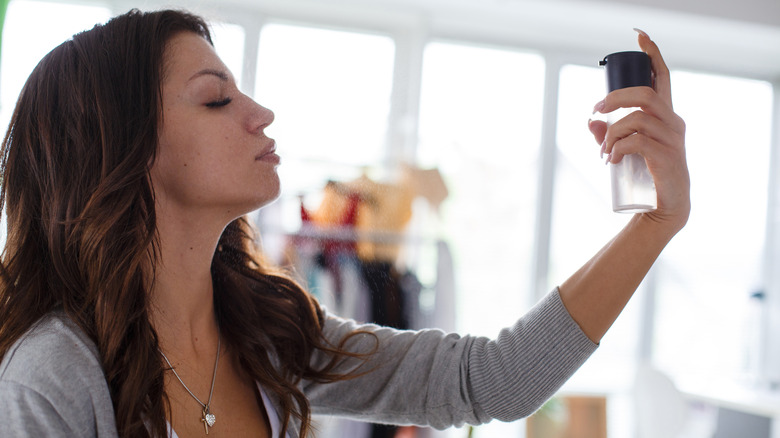How To Prep Your Skin Before Using Liquid Blush
We may receive a commission on purchases made from links.
Nothing gives your skin a youthful glow better than a swipe of rouge. While bronzer and contour are considered major face-altering makeup products, many people underestimate the flattering effects of blush — more specifically, liquid blush. Powder blush has long been a go-to option, but applying blush with a watery consistency can enhance your look thanks to its radiant finish and seamless application. The only downside to using a liquid blush is that it requires more precision and skin prep than a traditional powder blush. This can deter people from using it even though it has the potential to seriously upgrade your makeup game.
Nevertheless, don't let liquid blush's learning curve prevent you from adding this product to your makeup kit. Once you learn how to adjust your routine for liquid blush, you'll be hard-pressed to give it up. Master your makeup by following our liquid blush tips for a perfectly blended look.
Liquid vs. powder blush
It's fun to experiment with various shades and formulations of blush, as all forms of blush can transform your look, though different consistencies, such as a liquid or powder blush, offer varying benefits. For instance, liquid blush is typically more pigmented than powder blush. Liquid blush also leaves a glowy finish, so it suits certain skin types better than others. "Liquid blush is most ideal for normal and dry to mature skin types, as it tends to provide a more hydrated, natural look," makeup artist and esthetician Lynnette Cole told Byrdie. Therefore, if you're going for a dewy makeup look, such as the healthy skin beauty trend, opt for a liquid blush rather than a powder one.
On the other hand, reach for a powder if you prefer a subtle flush of color. Powder formulas are buildable and easier to use, as they allow you to better control the amount of product you apply. Furthermore, this type of blush works well with matte makeup because it produces a soft, airbrushed finish. For this reason, powder blush is best for oily skin, as it won't slide around or create any shine. However, powder blush fades quickly, and you often need to reapply it throughout the day, so consider liquid blush if you aren't too keen on touching up your makeup on the go.
To start, treat your skin with serums
For an ultra-glowy base, incorporate a high-quality face serum into your routine. More specifically, look for serums that target skin concerns such as dullness or dryness. For instance, use a vitamin C serum to brighten your skin and help you achieve an even complexion. You can also look for an under-eye brightener to reduce the appearance of dark circles, as shadows above the cheekbones can distract from the rest of your makeup.
Additionally, don't forget to use a moisture-boosting serum that contains ingredients such as hyaluronic acid and squalene, as board-certified dermatologist Dr. Mamina Turegano told InStyle. These hydrating and brightening serums not only address pigmentation or uneven skin tone but also enhance your makeup. However, remember to apply your serums "after cleansing and before moisturizing" for better absorption (via MedicalNewsToday). You can also exfoliate your skin before applying a serum to buff away dead skin cells and improve overall texture, according to WebMD.
Then, moisturize your skin
Unlike powder blush, liquid blush is less likely to settle into creases or appear cakey once applied. However, this doesn't exempt you from needing to prepare your skin. Even though most liquid blush products contain hydrating ingredients, you should still make sure you're working with a healthy base, as this will help your liquid blush apply more seamlessly while preventing flaking or dryness.
Therefore, before applying blush, use a nourishing moisturizer (even if your serum is hydrating, too) and wait a few moments to allow the product to fully absorb into the skin. Opt for a moisturizer similar to the Neutrogena Hydro Boost Water Gel, which has a full five-star rating, or Tatcha's Dewy Skin Cream, which has four out of five stars, if you want a radiant finish. For those with oily skin, use a mattifying moisturizer to control excess sebum throughout the day.
Final prep: apply foundation and bronzer
And now to settle the age-old question of which comes first: blush or concealer. Liquid blush should be the last step in your makeup routine, so apply it after foundation, concealer, bronzer, and contour for the best results. "I love to apply liquid blush after I've done my face makeup," celebrity makeup artist Jamie Greenberg told Byrdie. "I usually will put on my foundation, concealer, contouring, or warmth, and then I do my blush."
This is also the easiest way to help your rouge stand out. It'll be difficult for the blush to shine through the other layers of product if applied too early in your makeup routine, resulting in a lackluster sheen rather than the lustrous glow you're trying to achieve. That said, blending your liquid blush underneath concealer or bronzer works well for individuals who prefer a more subtle pop of color.
What you'll need to apply liquid blush
If you're accustomed to using powders, liquid blush can appear intimidating, but like with any new product, liquid blush simply requires experimentation. However, the versatility of application denotes a major benefit of choosing liquid blush over powder.
"For first-time users, I'd recommend applying with fingers instead of sponges or brushes," Nikki Wolf, celebrity makeup artist and global director of artistry at KVD Beauty, told Bustle. "This can make you feel a little bit more in control of how much product you are putting on the skin." In general, a little product goes a long way. This especially applies if you've never used liquid blush before. It's best to use a small amount at first until you learn how much product you need to achieve your desired look. It's easier to slowly build the saturation than to remove excess pigment, after all.
What's more, it helps if your blush includes a tapered, doe-foot applicator for precision, but you can certainly make do without one. "I prefer applying liquid blush with a damp, fluffy brush," Lynnette Cole told Byrdie. "Beautyblenders, makeup brushes, and fingertips work really well when applying liquid blush, too."
How long does liquid blush last?
While the longevity of liquid blush may not compare to long-lasting powder blush, there are tricks you can follow to keep your blush in place without too many touch-ups. For instance, dab — not swipe — a thin layer of translucent powder on your cheeks after applying blush to keep it in place. Use your powder sparingly, however, to avoid a too-matte finish. You can also settle for a dewy setting spray if you're aiming for a glowy complexion. Using a grippy primer will also ensure your blush lasts throughout the day.
Although liquid blush is compatible with dryer skin types, babes with oily skin can also rock liquid blush. The key to mastering liquid blush application with combination or oily skin is counterbalancing the oil. You can do this by using a matte foundation or a mattifying setting product, such as a setting powder and oil-control setting spray. You can also use blotting papers, though you'll likely need to reapply your blush if you do.
